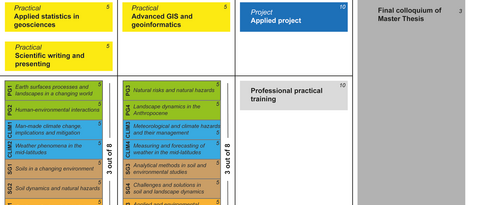
On 25 June 2025 at 16:30 there will be an information event in HS 222, Geography Building G1, on the new Master GEOSPHERES - Geographic Science Approaches to Environmental Challenges. The event is open to all interested students!
more
On 25 June 2025 at 16:30 there will be an information event in HS 222, Geography Building G1, on the new Master GEOSPHERES - Geographic Science Approaches to Environmental Challenges. The event is open to all interested students!
moreThe study „A Spatial Decision Support System for climate-adapted agriculture designed with and for stakeholders in West Africa“ presents a web-based system that enabels stakeholders from agriculture and related sectors to access information on the impacts of climate change across a wide range of indicators. In addition to the integration of regional stakeholders in the development process, data processing, and technical implementation, the study includes two case studies that illustrate the diverse capabilities of the system.
moreThe work by Ziegler et al. deals with the future development of climate indices that are relevant for agriculture in Africa on the basis of climate model enmsebles.
moreWe have published a new peer-reviewed study entitled "Analysis of Crop Suitability Index for Current and Future Climates Using Statistically Downscaled CMIP6 Outputs over Africa in Meteorological Applications by Gbode et al., analyzing the impact of climate change on the crop suitability index (CSI) of staple crops across Africa.
moreIn addition to focusing on the effects of anthropogenic climate change in Lower Franconia, which has been experienced first-hand by all those present, especially in recent years, another focus was on the question of the data basis - i.e. why we actually know so much about climate change.
moreThe study addresses the challenge of identifying models that can predict credible rainfall patterns in the future, amidst exisitng uncertainties in climate modeling. By comparing the ocean-coupled ROM model with the uncoupled regional model REMO, the results show that ROM offers a better representation of atmospheric baroclinicity linked to rainfall changes. This leads to more reliable projections, as ROM is grounded in mechanisms that are identifiable in observational and reanalysis data.
moreOn October 10, 2024, the annual meeting of geography department heads from Lower Franconia took place at the Armin-Knab-Gymnasium in Kitzingen. The event opened with a lecture by Dr. Daniel Abel on "Climate Change in Lower Franconia" in which he analyzed recent extreme events such as heatwaves, droughts, and heavy rainfall, while also examining possible future developments under various greenhouse gas scenarios.
moreAs part of the recently completed project LANDSURF, additional data has been published.
moreAs part of the BigData@geo2.0 project, Katrin Ziegler participated in the "Innovation Day Mainfranken 2024: Mainfranken's Companies in the Data Rush: Curse or Blessing."
moreOn August 22, the final stakeholder workshop of the WASCAL WRAP2.0 LANDSURF project took place with the presentation of a freely accessible Decision Support System (DSS). The system contains a large number of (agro-)climatic variables from both the past (1981-2010) and the future up to the end of the 21st century, assuming various greenhouse gas scenarios. The underlying data is based on an ensemble of high-resolution regional climate models. In addition, a similar system from the WASCAL WRAP2.0 FURIFLOOD project was presented, which focuses on hydrological aspects.
moreAs part of the BMBF project WASCAL WRAP2.0 LANDSURF, we have published a dataset with a large number of agricultural relevant indices for Africa. These include indices of temperature, heat, drought, and precipitation as well as various crop-specific indices of water availability for 12 different crops.
moreAs part of the course "klima.fit - Climate change on your doorstep! What can I do?" at the adult education centre Volkshochschule Würzburg & Umgebung e.V. Dr Luzia Keupp from our working group gave an insight on 14 May 2024 on
the expected effects of climate change in the Würzburg region.
moreWe have a new publication in Theoretical and Applied Climatology: Rai et al. (2024) are the first who investigated how different temperature- and precipitation-based climate indices will change under the influence of climate change by using data from CORDEX-CORE instead of the older CORDEX-CAS-44 data or solely a single simulation.
moreWe have published a new study on the cooling effect of urban trees and green spaces in the journal Landscape and Urban Planning (Rahman et al. 2024).
more